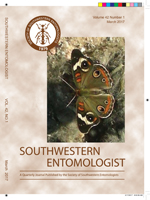The Mexican bean beetle, Epilachna varivestis Mulsant, is an important pest of bean (Phaseolus vulgaris L.) crops in Mexico and eastern United States. The Beauveria bassiana isolates TM0307 and SyDBbh5001M require large amounts to be effective in the field. Liquid culture medium containing cotton (Gossypium hirsutum L.) flour was evaluated to improve their virulence against E. varivestes. Virulence of B. bassiana blastospores was evaluated using various culture media and Sabouraud dextrose broth as a control, testing potential of cotton flour versus peptone as a nitrogen source, and colloidal chitin and Lepidoptera exuvia as sources of chitin. Samples were collected every 24 hours, and production of cuticle-degrading proteases (Pr1 and Pr2) and chitinase (NAGase) was determined during 5 days. The lowest enzyme production was observed in Sabouraud dextrose broth and colloidal chitin cultures, whereas the highest production was observed in chitin with cotton flour (Pr1 = 23.2, 2.3, and 126.2 U/ml; Pr2 = 12.7, 2.3, and 48.7 U/ml; NAGase = 5.4, 0.6, and 9.1 U/ml in Sabouraud dextrose broth, colloidal chitin, and chitin with cotton flour cultures, respectively). The LC50 in chitin with cotton flour versus Sabouraud dextrose broth media was evaluated by testing six doses against E. varivestis third-instar larvae; median survival time (ST50) was measured by testing 1 × 108 blastospores per milliliter. Significant lower LC50 and ST50 values were observed by blastospores produced in chitin with cotton flour medium (2.1 ± 1.7 to 2.8 × 106 blastospores per milliliter and 2 days), compared with those on Sabouraud dextrose broth (9.8 ± 6.3 to 15.9 × 106 blastospores per milliliter and 4 days), respectively. Results indicated potential of cotton flour to increase virulence of B. bassiana blastospores against E. varivestis third-instar larvae by enhancing production of insect cuticle-degrading enzymes.
How to translate text using browser tools
1 March 2017
Beauveria bassiana Blastospores Produced in Selective Medium Reduce Survival Time of Epilachna varivestis Mulsant Larvae
Jesus E. Castrejon-Antonio,
Gricelda Nuñez-Mejia,
Maria M. Iracheta,
Ricardo Gomez-Flores,
Fernando Tamayo-Mejia,
Jaime A. Ocampo-Hernandez,
Patricia Tamez-Guerra
ACCESS THE FULL ARTICLE

Southwestern Entomologist
Vol. 42 • No. 1
March 2017
Vol. 42 • No. 1
March 2017




